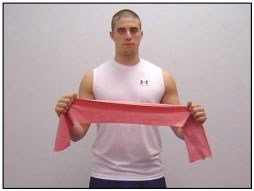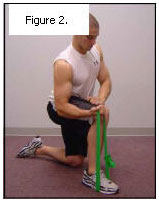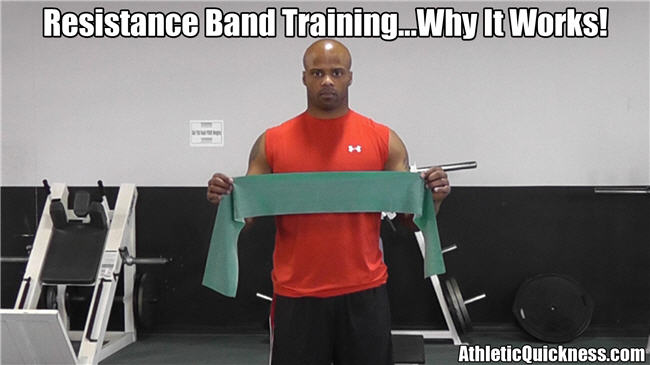Why Isometrics and Resistance Band Training for Speed
Gives Results Not Available With Weight Training
or Any Other Type of Workout
Including Other Forms of Band Exercises
“Helps Athletes Improve Their Sports Performance
and Advance Their Athletic Careers”
One of the more popular types of training aids is what is known as the resistance band or exercise band.

Figure 1. The resistance or exercise band
This is an outstanding product that has a very unique physical property known as a variable elastic potential. This means that the more you stretch the band, the more force you will have to apply to maintain the resistance level.
The amount of resistance found within an elastic band is therefore a function of its length when stretched. When the length of the band changes, even if by a small amount, the resistance level changes also.
Here’s a very basic idea of how and why the resistance band, when used with an isometric training strategy, will far outperform weights when training for speed:

Figure 2. Biceps Curl Using the Band
Imagine first that you are performing a biceps curl, much like that shown in Figure 2 above, except instead of holding a weight, you are holding one end of a resistance band with the other end either attached to the floor or perhaps secured under your foot.
Since you are using an isometric contraction, you keep the elbow flexed at about 90 degrees and hold it in that position for 10-15 seconds without moving it.
While holding this position, the band is stretched and exerting a significant amount of force back into your biceps muscle. After a few seconds, your biceps muscle will naturally start to weaken. When this happens, your arm will start to drop and your biceps muscle will begin to recruit more and more motor units to help keep your arm and elbow in the fixed position.
When your muscles start to shake, keep holding the position. Eventually, and rather quickly if the resistance is high enough, you get to the point where you can no longer hold the band still and maintain the same fixed position. This causes your arm to give-out or start to shake a little as the muscle weakens and your coordination dissipates. This is a desired state for your muscles to be in to train them for speed and quickness.
These movements in your elbow and arm, however small and in whichever direction, instantaneously alters the amount of resistance being applied by the band as the length of the band changes. Even slight changes in resistance, whether greater or less than the original, will affect the amount of force your muscles exert to hold the position.
Your muscles are becoming alert and responsive. Your muscles are constantly perceiving or sampling these small changes in resistance and must continually and immediately alter the amount of force being applied to hold the position. They do this by altering their typical recruitment pattern of motor units to try and maintain the held position.
This sampling and responsiveness to the resistance by the muscle is continual as the muscle fights to hold the position. As this happens, your biceps muscle will begin to recruit more and more motor units to help keep your arm and elbow in the fixed position.
Weaknesses are discovered and eliminated. This is a great benefit to athletes because with each new recruitment pattern of motor units, a muscle’s weakness and lack of coordination is instantly exposed on a much deeper level than normally experienced. This forces the muscle fibers to immediately get stronger and quicker and with more precision than before.
The result is that the muscles are conditioned to contract faster with increased strength, coordination and responsiveness. An athlete will start to notice the difference in their athletic performance often in just a few days.
Weights Aren’t Made for This
An athlete cannot get the same results when using weights in an isometric routine. This is because of the difference between gravitational force (used by weights) and elastic force (used by the resistance band). Gravitational force never changes, no matter how great the mass of the object; therefore, the muscle does not go through the process of resampling and responding to any changes in resistance and does not develop the same level of responsiveness and quickness.
A second benefit of this training strategy is that the muscle does not get a chance to adapt to the force of the resistance and plateau, or level off, at the level of resistance applied. “Muscle confusion” is the term often applied to the idea of keeping the muscle guessing as to what force to expect, and this promotes ongoing muscle development.
Third, the mass of the muscle typically does not increase with this type of training, which, if it did, could potentially offset speed gains. So, whenever you are able to increase a muscle’s strength and coordination without adding any additional body weight, your speed, quickness and athletic performance will automatically improve.
These are just some of the reasons how and why this type of training works and why athletes see dramatic results in their sports performance in a short period of time.
Bands Supply Resistance In Multiple Angles and Directions
Imagine now applying this strategy in not only conventional ways, as in the biceps example here, but also by using the band in positions and angles you may have never thought of before that will immediately expose and then eliminate even greater weaknesses in your athletic performance.
Therefore we use the resistance band with an isometric training strategy to increase the strength, coordination, and contraction rate within specific muscles used in your sports skills.
Using this resistance band training technique will help you and any other athlete get faster more quickly and achieve their athletic goals.






